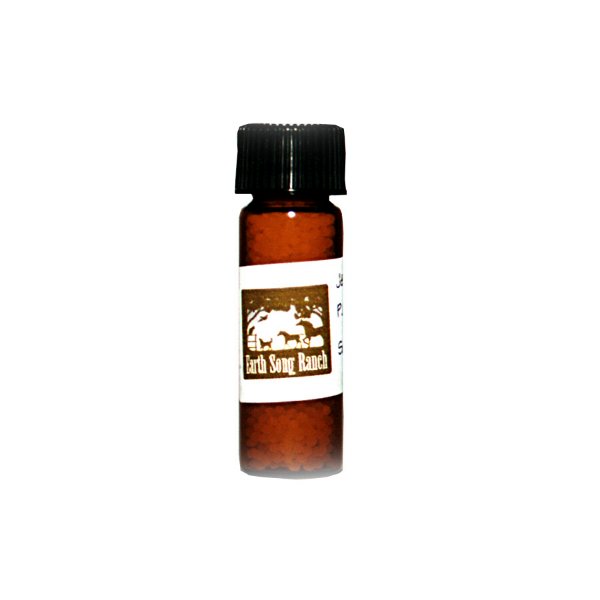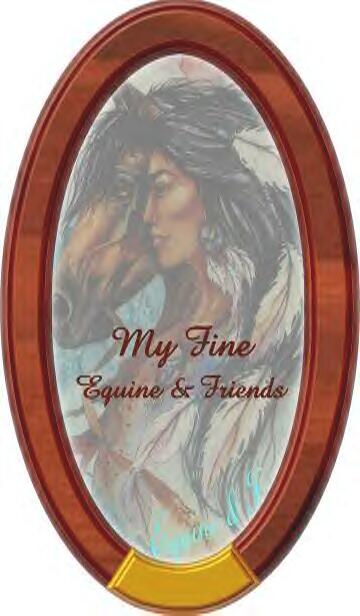
Horse, Dog, Cat, Nosodes
Equine Solutions Catalog Page 22a

NOSODES - by
(The Holistic Vet Clinic)
![]()
Herbal Wormer & Eye Health Support Herbs (Uveitis/Glaucoma)
Equine Equine-Zyme, Dog and Cat Equine-Zyme, Beta Glucan, Joint-Zyme, MSM, Glucosamine,
Mare, Foal, Stallion, Senior Zyme, Yeasture
for non-equine livestock,
Cushings, EPM, Hoof Builder, Tummy-Zymes
Pure Herbs and Herb Blends
Nosodes
![]()
Nosodes are Homeopathic Immunizations that are given in tiny sugar pill form,
monthly, that have no side effects, and are very effective in disease prevention.
all are 30C strength
See article below.

HORSES
1 dram bottles will last up to 5 horses 1 yr. 2 dram will last up to 10 horses 1. yr.
You can administer the little sugar pills between their lip and gums or you
can make a spray to spray on the gums. To build up the immune system,
Start out 1 time for 3 days in a row,
then 1 time per week for a month and then 1 time a month from there on to
maintain constant built up immune system.
If your horse, dog or cat already has an illness, we have homeopathic
protocols for them. Just email me to inquire: orders@myfineequine.com
Equine Herpes Virus 4 oz 1 dram $25.00 2 dram $45

Equine herpesvirus 1
From Wikipedia, the free encyclopedia
Jump to: navigation, search
Equine herpesvirus 1
Virus classification
Group: Group I (dsDNA)
Family: Herpesviridae
Genus: Varicellovirus
Species: Equine herpesvirus 1 (EHV-1)
Equine herpesvirus 1 (EHV-1) is a virus of the family Herpesviridae that causes abortion in horses. Initial spread
of EHV-1 by a newly introduced horse through direct and indirect contact can lead to abortion and perinatal infection
in up to 70 percent of a previously unexposed herd.[1] Abortion usually occurs in the last four months of gestation,
two to four weeks after infection of the mare.[2] Perinatal (around the time of birth) infection can lead to pneumonia
and death. Encephalitis can occur in affected animals, leading to ataxia, paralysis, and death. There is a vaccine
available, however it’s efficacy is questionable.
Recent molecular epidemiology studies have identified a single nucleotide polymorphism (SNP) which varies between
EHV-1 field isolates and shows a highly statistically significant correlation with paralytic compared with non-paralytic
disease outbreaks [3] . The SNP corresponds to a single amino acid change in the DNA polymerase enzyme, which is
an essential enzyme for replication of viral DNA. This is a significant finding, suggesting that a point mutation
in a single virus gene has a major impact upon likely disease severity during an outbreak.
In 2006, an outbreak of EHV-1 among stables in Florida resulted in the institution of various quarantine measures.[4]
The outbreak was determined to have originated with several horses imported from Europe via New York, and then
shipped to Florida.[5]
[edit] References
^ Fenner, Frank J.; Gibbs, E. Paul J.; Murphy, Frederick A.; Rott, Rudolph; Studdert, Michael J.; White, David
O. (1993). Veterinary Virology (2nd ed.). Academic Press, Inc. ISBN 0-12-253056-X.
^ Carter, G.R.; Flores, E.F.; Wise, D.J. (2006). Herpesviridae. A Concise Review of Veterinary Virology. Retrieved
on 2006-06-08.
^ Nugent J, Birch-Machin I, Smith K, Mumford J, Swann Z, Newton J, Bowden R, Allen G & Davis-Poynter N. Analysis
of Equid Herpesvirus 1 Strain Variation Reveals a Point Mutation of the DNA Polymerase Strongly Associated with
Neuropathogenic versus Nonneuropathogenic Disease Outbreaks. Journal of Virology. Retrieved on 2007-02-02.
^ Equine Herpes Virus type1 Status Report – Florida. Florida Department of Agriculture and Consumer Services. Retrieved
on 2007-01-05.
^ EHV-1, Outbreak Background. Florida Department of Agriculture and Consumer Services. Retrieved on 2007-01-05.
This virus-related article is a stub. You can help by expanding it.
This veterinary medicine related article is a stub. You can help by expanding it.
Retrieved from "http://en.wikipedia.org/wiki/Equine_herpesvirus_1"
Categories: Virus stubs | Veterinary medicine stubs | Herpesviruses | Horse diseases | Animal virology
Equine herpesvirus 2
From Wikipedia, the free encyclopedia
Jump to: navigation, search
Equine herpesvirus 2
Virus classification
Group: Group I (dsDNA)
Family: Herpesviridae
Genus: Rhadinovirus
Species: Equine herpesvirus 2 (EHV-2)
Equine herpesvirus 2 (EHV-2) is a virus of the family Herpesviridae, originally known as equine cytomegalovirus
due to its slow replication in tissue culture. However, complete sequencing of the EHV-2 genome has demonstrated
that it is a member of the subfamily Gammaherpesvirinae, in the genus Rhadinovirus .[1] . It has an uncertain role
in respiratory disease in horses, but EHV-2 has been isolated from cases exhibiting symptoms such as coughing,
conjunctivitis, and swollen submaxillary and parotid lymph nodes.[2]
[edit] References
^ Telford EA, Watson MS, Aird HC, Perry J & Davison AJ.. "The DNA sequence of equine herpesvirus 2".
^ Fenner, Frank J.; Gibbs, E. Paul J.; Murphy, Frederick A.; Rott, Rudolph; Studdert, Michael J.; White, David
O. (1993). Veterinary Virology (2nd ed.). Academic Press, Inc. ISBN 0-12-253056-X.
This virus-related article is a stub. You can help by expanding it.
This veterinary medicine related article is a stub. You can help by expanding it.
Retrieved from "http://en.wikipedia.org/wiki/Equine_herpesvirus_2"
Categories: Herpesviruses | Horse diseases | Animal virology | Virus stubs | Veterinary medicine stubs
Equine herpesvirus 3
From Wikipedia, the free encyclopedia
Jump to: navigation, search
Equine herpesvirus 3
Virus classification
Group: Group I (dsDNA)
Family: Herpesviridae
Genus: Varicellovirus
Species: Equine herpesvirus 3 (EHV-3)
Equine herpesvirus 3 (EHV-3) is a virus of the family Herpesviridae that affects horses. It causes a disease known
as equine coital exanthema. The disease is spread through direct and sexual contact and possibly through flies
carrying infected vaginal discharge.[1] EHV-3 has an incubation period of as little as two days.[2] Signs of the
disease include pustules and ulcerations of the vagina, penis, prepuce, and perineum. Lesions may also be seen
on the lips and teats. Usually the only symptom seen is a decreased libido in stallions. The lesions heal within
two weeks.[2] As with other herpes viruses, the virus remains latent in the host for life. Carrier animals can
sometimes be identified by spots of pigment loss on black skin in the genital region. EHV-3 is best prevented by
taking note of present clinical signs and keeping infected horses isolated and breeding stock from sexual contact
with other horses. Antibiotic ointments should be used on the lesions to prevent secondary bacterial infections
and hasten the healing process. It is also important to use disposable gloves and instruments in veterinary exams
as the virus can be spread by using contaminated equipment.
[edit] References
^ Carter, G.R.; Flores, E.F.; Wise, D.J. (2006). Herpesviridae. A Concise Review of Veterinary Virology. Retrieved
on 2006-06-08.
^ a b Fenner, Frank J.; Gibbs, E. Paul J.; Murphy, Frederick A.; Rott, Rudolph; Studdert, Michael J.; White, David
O. (1993). Veterinary Virology (2nd ed.). Academic Press, Inc. ISBN 0-12-253056-X.
This virus-related article is a stub. You can help by expanding it.
This veterinary medicine related article is a stub. You can help by expanding it.
Retrieved from "http://en.wikipedia.org/wiki/Equine_herpesvirus_3"
Categories: Horse diseases | Herpesviruses | Animal virology | Virus stubs | Veterinary medicine stubs
Equine herpesvirus 4
From Wikipedia, the free encyclopedia
Jump to: navigation, search
Equine herpesvirus 4
Virus classification
Group: Group I (dsDNA)
Family: Herpesviridae
Genus: Varicellovirus
Species: Equine herpesvirus 3 (EHV-3)
Equine herpesvirus 4 (EHV-4) is a virus of the family Herpesviridae that cause rhinopneumonitis in horses. It is
the most important viral cause of respiratory infection in foals.[1] Like other herpes viruses, EHV-4 causes a
lifelong latent infection in affected animals. These horses are usually the source for new infection for foals
over two months old, weanlings, and yearlings. Symptoms include fever, loss of appetite, and discharge from the
nose. Most infected animals recover in one to three weeks,[2] but death can occur in environments with overcrowding
and other stress factors. There is a vaccine available.
[edit] References
^ Fenner, Frank J.; Gibbs, E. Paul J.; Murphy, Frederick A.; Rott, Rudolph; Studdert, Michael J.; White, David
O. (1993). Veterinary Virology (2nd ed.). Academic Press, Inc. ISBN 0-12-253056-X.
^ Carter, G.R.; Flores, E.F.; Wise, D.J. (2006). Herpesviridae. A Concise Review of Veterinary Virology. Retrieved
on 2006-06-04.
This virus-related article is a stub. You can help by expanding it.
This veterinary medicine related article is a stub. You can help by expanding it.
Retrieved from "http://en.wikipedia.org/wiki/Equine_herpesvirus_4"
Categories: Herpesviruses | Horse diseases | Animal virology | Virus stubs | Veterinary medicine stubs
Equine herpesvirus
From Wikipedia, the free encyclopedia
(Redirected from Equine herpes virus)
Jump to: navigation, search
Equine herpesvirus is a group of viruses of the family Herpesviridae that affect horses.
Equine herpesvirus 1 of the subfamily Alphaherpesvirinae and genus Varicellovirus
Equine herpesvirus 2 of the subfamily Gammaherpesvirinae and genus Rhadinovirus
Equine herpesvirus 3 of the subfamily Alphaherpesvirinae and genus Varicellovirus
Equine herpesvirus 4 of the subfamily Alphaherpesvirinae and genus Varicellovirus
Equine herpesvirus 5 of the subfamily Gammaherpesvirinae and genus Rhadinovirus
Retrieved from "http://en.wikipedia.org/wiki/Equine_herpesvirus"
Categories: Horse diseases | Herpesviruses

Use the Navigation Bars for quick and easy access.

You can contact us by Snail Mail at: